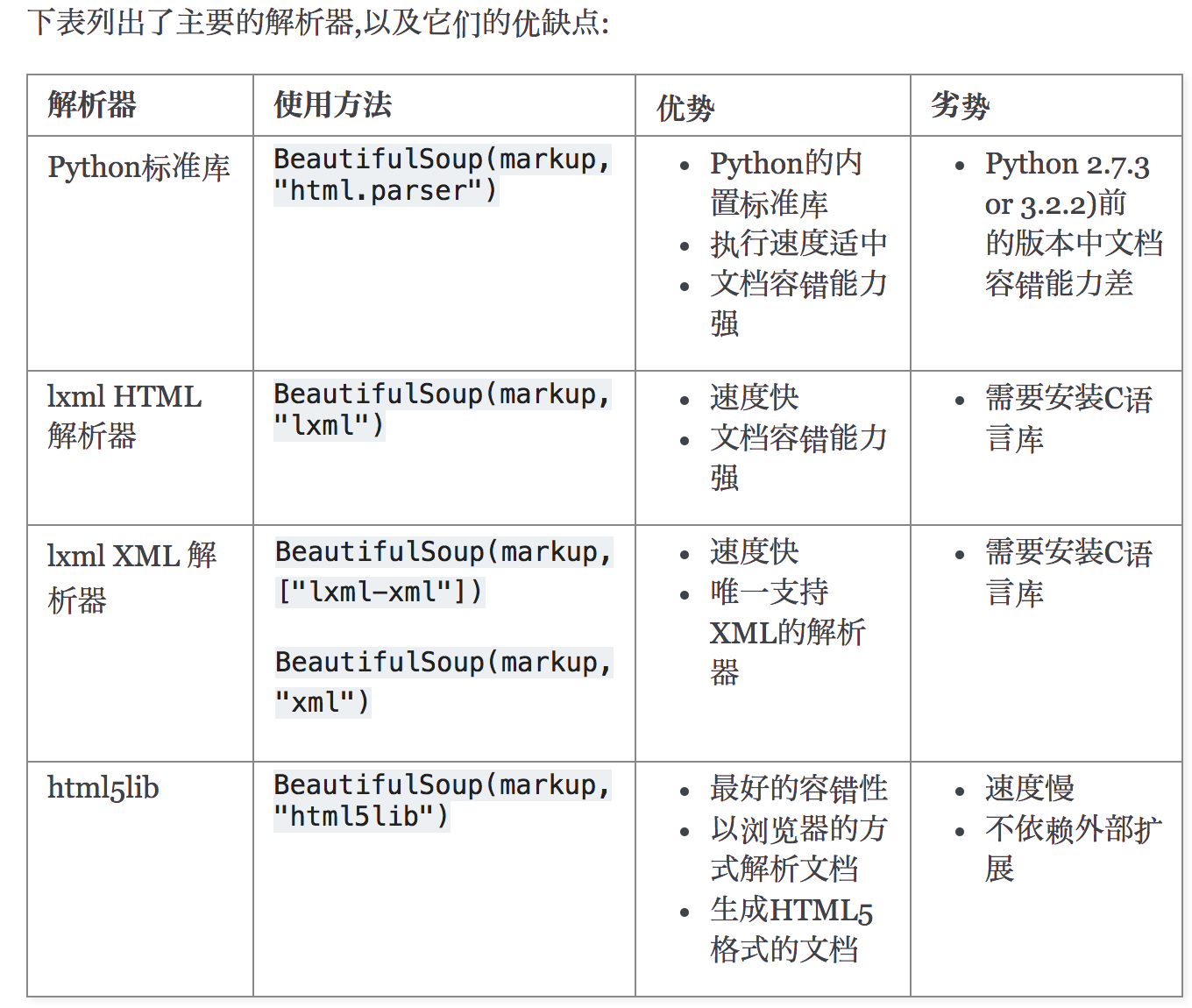django-beautifulsoup的简单使用
一:介绍:简单来说,Beautiful Soup是python的一个库,最主要的功能是从网页抓取数据。官方解释如下:
''' Beautiful Soup提供一些简单的、python式的函数用来处理导航、搜索、修改分析树等功能。 它是一个工具箱,通过解析文档为用户提供需要抓取的数据,因为简单,所以不需要多少代码就可以写出一个完整的应用程序。 '''
1,安装
pip3 install beautifulsoup4
pip3 install bs4 #再 from bs4 import beautifulsou
解析器
Beautiful Soup支持Python标准库中的HTML解析器,还支持一些第三方的解析器,如果我们不安装它,则 Python 会使用 Python默认的解析器,lxml 解析器更加强大,速度更快,推荐安装。
pip3 install lxml
另一个可供选择的解析器是纯Python实现的 html5lib , html5lib的解析方式与浏览器相同,可以选择下列方法来安装html5lib:
pip install html5lib
解析器对比

二:快速开始
下面的一段HTML代码将作为例子被多次用到.这是 爱丽丝梦游仙境的 的一段内容(以后内容中简称为 爱丽丝 的文档):
html_doc = """ <html><head><title>The Dormouse's story</title></head> <body> <p class="title"><b>The Dormouse's story</b></p> <p class="story">Once upon a time there were three little sisters; and their names were <a href="http://example.com/elsie" class="sister" id="link1">Elsie</a>, <a href="http://example.com/lacie" class="sister" id="link2">Lacie</a> and <a href="http://example.com/tillie" class="sister" id="link3">Tillie</a>; and they lived at the bottom of a well.</p> <p class="story">...</p> """
使用BeautifulSoup解析这段代码,能够得到一个 BeautifulSoup 的对象,并能按照标准的缩进格式的结构输出: from bs4 import BeautifulSoup soup = BeautifulSoup(html_doc, 'html.parser') print(soup.prettify())
格式化以后,就会成为下面的格式

<html> <head> <title> The Dormouse's story </title> </head> <body> <p class="title"> <b> The Dormouse's story </b> </p> <p class="story"> Once upon a time there were three little sisters; and their names were <a class="sister" href="http://example.com/elsie" id="link1"> Elsie </a> , <a class="sister" href="http://example.com/lacie" id="link2"> Lacie </a> and <a class="sister" href="http://example.com/tillie" id="link3"> Tillie </a> ; and they lived at the bottom of a well. </p> <p class="story"> ... </p> </body> </html>
几个简单的浏览结构化数据的方法:
soup.title # <title>The Dormouse's story</title> soup.title.name # u'title' soup.title.string # u'The Dormouse's story' soup.title.parent.name # u'head' soup.p # <p class="title"><b>The Dormouse's story</b></p> soup.p['class'] # u'title' soup.a # <a class="sister" href="http://example.com/elsie" id="link1">Elsie</a> soup.find_all('a') # [<a class="sister" href="http://example.com/elsie" id="link1">Elsie</a>, # <a class="sister" href="http://example.com/lacie" id="link2">Lacie</a>, # <a class="sister" href="http://example.com/tillie" id="link3">Tillie</a>] soup.find(id="link3") # <a class="sister" href="http://example.com/tillie" id="link3">Tillie</a>
从文档中找到所有<a>标签的链接: for link in soup.find_all('a'): print(link.get('href')) # http://example.com/elsie # http://example.com/lacie # http://example.com/tillie
从文档中获取所有文字内容
print(soup.get_text())
三,使用方法
将一段文档传入BeautifulSoup 的构造方法,就能得到一个文档的对象, 可以传入一段字符串或一个文件句柄.
from bs4 import BeautifulSoup soup = BeautifulSoup(open("index.html")) soup = BeautifulSoup("<html>data</html>")
然后,Beautiful Soup选择最合适的解析器来解析这段文档,如果手动指定解析器那么Beautiful Soup会选择指定的解析器来解析文档。
对象的种类
Beautiful Soup将复杂HTML文档转换成一个复杂的树形结构,每个节点都是Python对象,所有对象可以归纳为种
Tag , NavigableString , BeautifulSoup , Comment .




